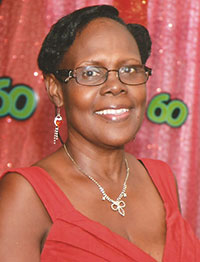TODAY we take time to celebrate all of the women who have had the good fortune of caring for the child/children in their lives. It is a difficult and sometimes thankless job, but I’m sure

most would agree that the world is a much better place because of the great work they’ve done. This week I’d like to share the story of one woman who has, over the years, managed to nurture an early affinity for art into a thriving business as a textile artist, all while balancing her life as a working mother.
Merleen Forde grew up in the village of Sparendaam on the East Coast of Demerara. She described art as being one of her best subjects in school in spite of the doubts her father had about where a career in the subject could possibly take her. Nevertheless, it was her father who eventually suggested becoming a “commercial artist” as he described it, instead of a traditional, fine art practitioner. Forde considered his suggestion and soon began a rather unconventional journey to becoming a textile artist.
“When I started my work life I started with my father, as a secretary in his business. After that, I worked as a secretary at Guyana Stores Ltd in the agricultural machinery section for a couple of years. When I was at Guyana Stores, my father started a garment factory and was encouraging me to go and work with him. I got my daughter in 1985 and I worked with him up to 1986. After that, I worked with a company called Construction Management Combine Ltd in the personnel section. I left there in 1989 and came back to work with my father which I did until 1993.”

She went on to describe how her love for designing and sewing her own clothes survived in spite of the various administrative positions she often found herself in.
“I always enjoyed sewing and designing my own clothes. When my father had the factory, we were using fabrics from Sanata Textiles. We had a good market and would supply clothing to different companies. I would do some designs for him and he would put out a sample for persons to place orders. While designing my own outfits, I would go to church and persons would ask who made my outfit or where I got it. I would tell them that I sewed it myself and then they would ask me to sew for them. So that’s how I got started.
I left my father’s business in 1993. My daughter was eight-years-old at the time. I wanted to work at home, so that when she got home from school in the afternoons I would be there to pay attention to her schoolwork. So I was happy when I was home.”
Forde spoke fondly of her decision to work from home, a decision that allowed her to better monitor her daughter’s progress in school and also provided the kind of flexibility she needed as a budding textile artist. She admitted that at one point she provided private typing services for students at the University of Guyana before shifting her focus entirely to her textile production, as more orders for her unique  clothing eventually rolled in.
clothing eventually rolled in.
She believes strongly that we must remain open to learning new things every day. In fact, years after completing her secondary education, Forde went on to pursue a number of supplementary evening courses at the E.R. Burrowes School of Art in painting, ceramics, textiles and leatherwork between the years 2006 and 2009, and a course in fashion design in August of 2012. In addition to those courses, she also enrolled at the Carnegie School of Home Economics to learn the art of decorating and curtain-making, among other things. She also completed courses in tie-dye and batik, which were offered at the time by the Adult Education Association (AEA).
Forde went on to describe how she came to be affiliated to the Guyana Women Artists’ Association (GWAA), a group that has been actively hosting exhibitions, workshops and various outreach programmes across Guyana for the last 30 years.
“One day I went to a Women Artists’ exhibition at the National Library and I was impressed with the work on display. I saw Sonia Hamilton and asked her how to join the organisation. She told me to speak with Anna Correia, which I did. I went through the application process and started exhibiting with GWAA in 2006. And I guess the rest is history. I’ve also shown work at GuyExpo, Women in Business in Suriname and Go-Invest Canada, to list a few.”
Although she admits her challenges have been few over the years, Forde did say that she would like to see a more consistent supply of quality materials such as paints, fabrics and trimmings in the local market. Another concern of hers was the availability of funds to support the careers of creative professionals.
“I think grants could be more readily available to artists rather than loans, because loans have to be repaid by a certain time. Sometimes the money you make doesn’t come in time to make the payment by that date and the bank won’t wait on you.”
Nevertheless, Forde remains positive about her career as a textile artist, insisting that it is one of the most “certain” areas in the creative industry. There is always a demand for unique clothing that will set each person apart from the crowd and this, she says, is what keeps her in business.



.jpg)










